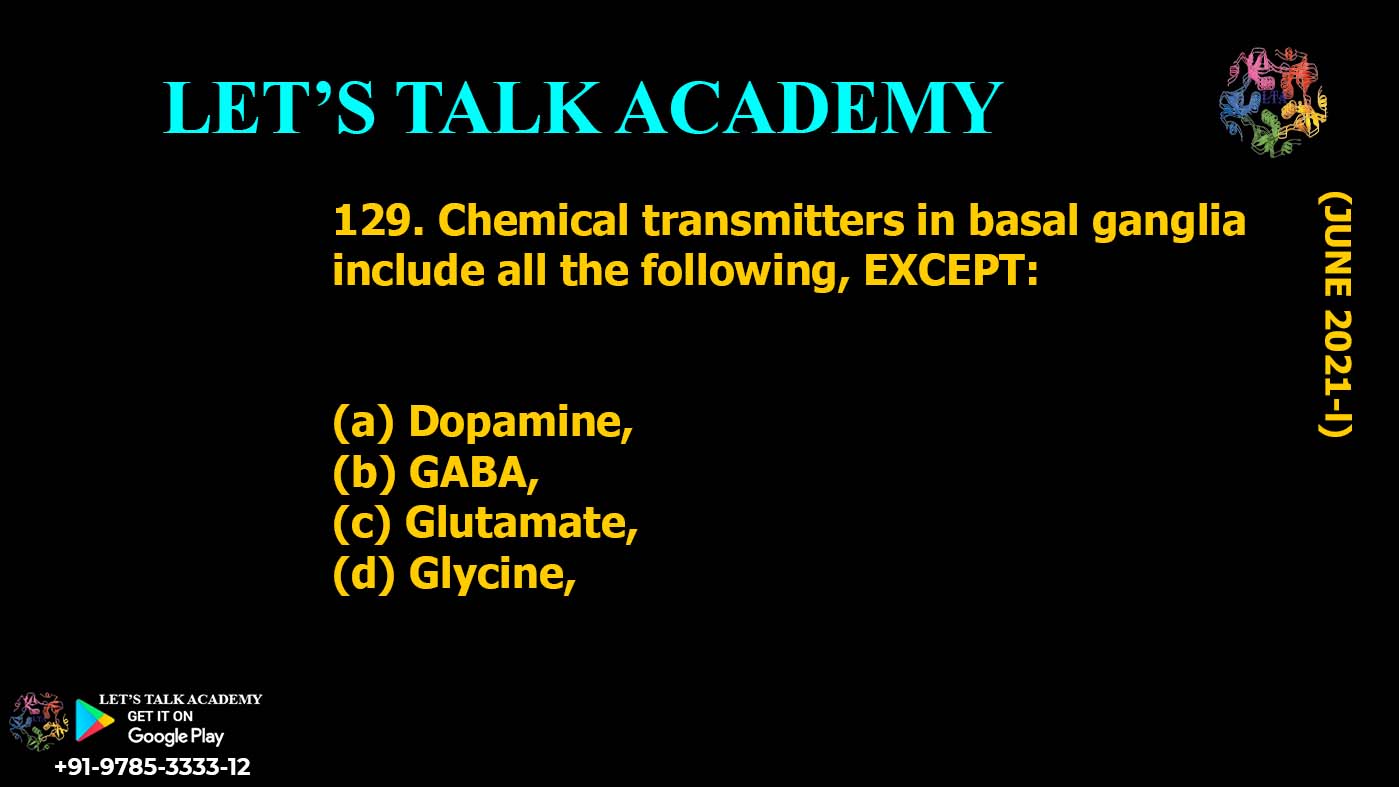129. Chemical transmitters in basal ganglia include all the following, EXCEPT:
(a) Dopamine,
(b) GABA,
(c) Glutamate,
(d) Glycine
Understanding Chemical Transmitters in the Basal Ganglia
Introduction
The basal ganglia, a group of nuclei in the brain, play an essential role in controlling movement, motor learning, and habit formation. These functions are largely mediated by a variety of chemical transmitters, or neurotransmitters, that facilitate communication between the neurons in the basal ganglia circuits. Some neurotransmitters are excitatory, while others are inhibitory, helping to fine-tune motor activity and maintain balance.
In this article, we will examine the major chemical transmitters in the basal ganglia and explore their specific roles. We will also highlight one neurotransmitter that is not typically involved in basal ganglia function.
Major Chemical Transmitters in the Basal Ganglia
1. Dopamine
One of the most well-known neurotransmitters involved in the basal ganglia is dopamine. Dopamine plays a central role in modulating motor control and movement. It is primarily produced in the substantia nigra, a part of the basal ganglia. Dopamine facilitates the proper functioning of motor pathways and helps regulate the smooth execution of movements. A deficiency of dopamine in the basal ganglia is a hallmark of Parkinson’s disease, leading to tremors, rigidity, and bradykinesia (slowness of movement).
2. GABA (Gamma-Aminobutyric Acid)
GABA is the primary inhibitory neurotransmitter in the brain, including the basal ganglia. It plays a crucial role in dampening excessive neuronal activity and preventing overstimulation. GABAergic neurons help control the balance between excitatory and inhibitory signals in the basal ganglia, ensuring that movement is not excessive or too rigid. GABA’s inhibitory action is essential for the smooth coordination of motor control.
3. Glutamate
Glutamate is the main excitatory neurotransmitter in the brain and plays a key role in promoting neural activity. In the basal ganglia, glutamate is involved in activating pathways that facilitate movement. It works in opposition to GABA to regulate the excitability of neurons, ensuring that motor signals are balanced and appropriately timed. Glutamate’s role in the basal ganglia is essential for initiating and modulating voluntary movements.
4. Glycine
Unlike the other neurotransmitters mentioned, glycine is not commonly associated with basal ganglia function. Glycine is an inhibitory neurotransmitter that primarily acts in the spinal cord and brainstem, where it regulates motor reflexes and coordinates movements. However, its role in the basal ganglia is limited, and it is not one of the primary chemical transmitters involved in basal ganglia circuits.
The Role of Chemical Transmitters in Motor Control
The interaction between dopamine, GABA, glutamate, and other neurotransmitters within the basal ganglia is essential for the fine-tuning of motor control. An imbalance in these chemical transmitters can lead to various neurological disorders, such as Parkinson’s disease and Huntington’s disease.
-
Dopamine is crucial for initiating and coordinating movements.
-
GABA helps inhibit excessive movement, ensuring controlled motion.
-
Glutamate promotes the excitability of neurons and facilitates movement initiation.
-
Glycine, while essential for other functions, does not play a direct role in basal ganglia motor control.
Conclusion
The basal ganglia rely on a complex interplay of chemical transmitters to regulate motor function and ensure smooth and coordinated movement. Dopamine, GABA, and glutamate are integral to these processes, while glycine plays a minimal role in basal ganglia activity.
Understanding the functions of these chemical transmitters helps explain how the brain regulates motor skills and how disruptions in neurotransmitter balance can lead to movement disorders. For example, in Parkinson’s disease, the loss of dopamine in the basal ganglia leads to motor symptoms, while in other disorders, like Huntington’s disease, the balance of excitatory and inhibitory signals in the basal ganglia is disrupted.
By learning about the chemical transmitters involved in the basal ganglia, researchers and clinicians can develop better treatments for motor disorders and gain a deeper understanding of how the brain controls movement.




2 Comments
Pallavi gautam
April 22, 2025Donee
yogesh sharma
May 4, 2025Done sir ji